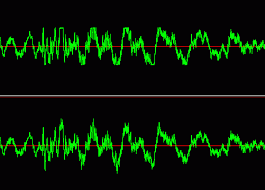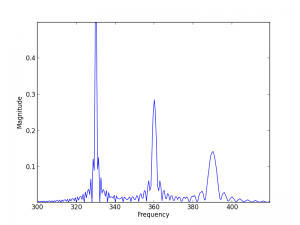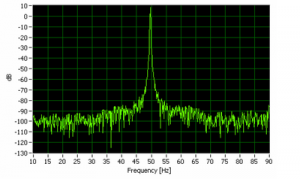The Synchronicity System does a LOT of mathematics! But that is true of almost all apps that involve taking data and spitting it out in a meaningful and easy way to you. What we do behind the scenes is look closely at your rein tension data and work out how smoothly rhythmical the connection between your hands and the horse’s mouth is. The methods we use to do this are similar to those that lie behind the speech recognition systems in your phone or tablet. In those applications the noisy set of sounds your voice makes when issuing your requests is broken down into a simple set of pure notes which are then recognised as words that have been programmed in to your system be it Cortana, Siri etc.
Your voice pattern looks a lot like your rein tension – here’s a real audio signal but it could easily represent the way your rein tension varies as you ride:

This, say, could be the left rein and right rein tension patterns. Somewhere in that noise there are some pure notes and one of those notes (in riding this would be the same as the stride frequency) dominates. Doing the calculation we can get a set of pure notes like this, where an audio signal has been found to have three closely spaced pure notes:

…and find out which one is the biggest and how much of a contribution it makes to the whole set of notes. In an ideal audio (or rein tension) signal such as this:

…there really is only one note and it would look like this after the calculation:

In riding, the frequency of this pure note is around 1 -3 cycles per second (Hertz) whereas in audio work the human ear detects sounds with note frequencies of around 16 cycles per second or higher.
Anyway, when Synchronicity finds that there is really only one dominant frequency component in your rein tension, it gives a high score – you get a ten for a pure note. When it calculates that there are a number of frequencies and the stride frequency is not very dominant you get a lower mark. This is like having noise in your rein contact. Striving to raise your mark essentially means finding a riding style and an acceptance from the horse that produces a beautiful pure note!
I read somewhere (can’t quite recall where) that finding a good contact is like discovering the “music of the reins” – how apt!
That’s what is special about the Synchronicity System.
Now, it also does a lot of less complicated things but things that may be very important for your riding.
It easily tells you whether your right rein carries more weight than your left, for instance and it lets you know when the rein tension is too high or too low. There’s a lot that can be dug out of the data – but that’s our job. You get totally reliable feedback on key measures of riding quality because of rock-solid mathematics – all hidden from view.
